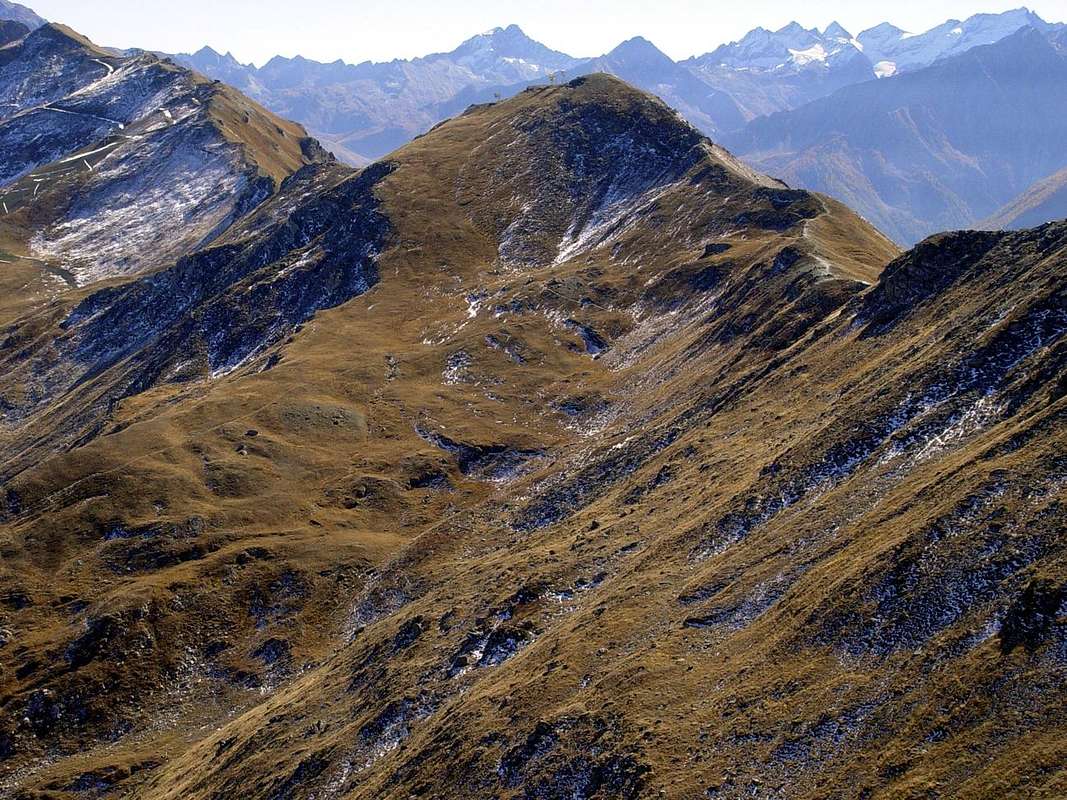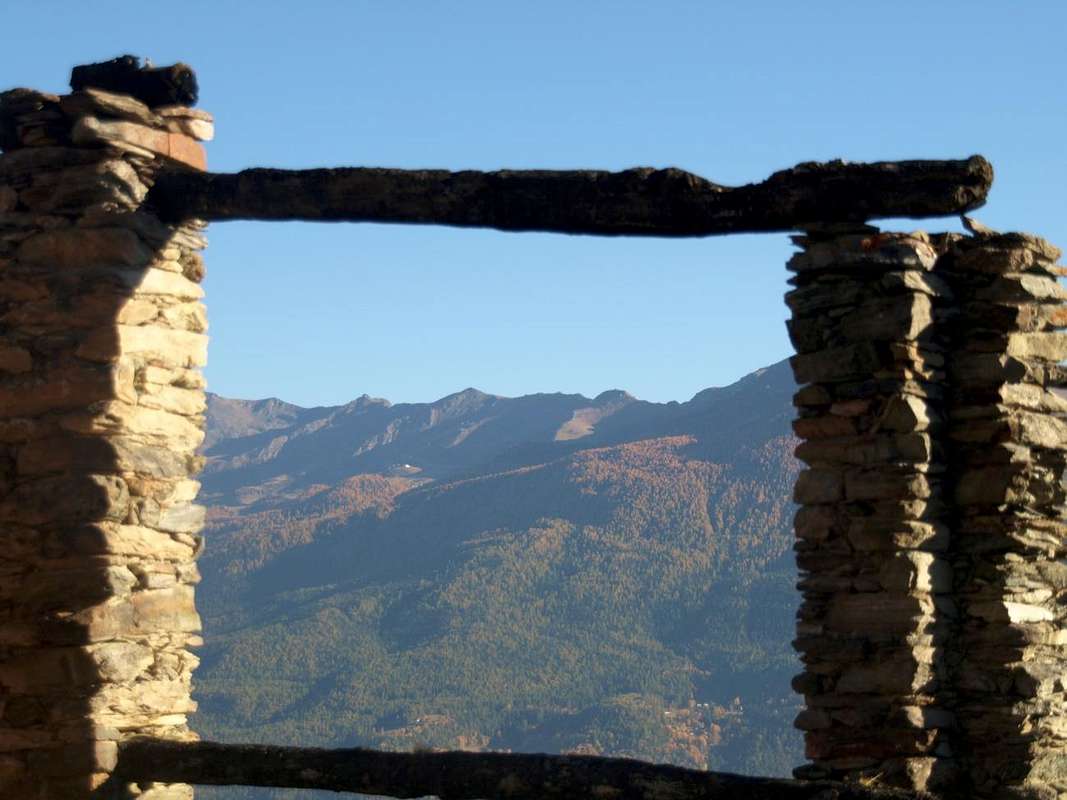-
 1520 Hits
1520 Hits
-
 81.18% Score
81.18% Score
-
 13 Votes
13 Votes
|
|
Mountain/Rock |
|---|---|
|
|
45.65350°N / 7.31283°E |
|
|
Hiking, Scrambling, Via Ferrata, Skiing |
|
|
Spring, Summer, Fall, Winter |
|
|
9029 ft / 2752 m |
|
|
Note
|
La montagna chiama i suoi figli, ed essi rispondono fedelmente al suo appello… Osvaldo Cardellina, Diario alpinistico, 1964-65 Page texts: @ OsvaldoCardellina "Osva", passed away on May 2, 2022. Page owners: Christian Cardellina e Osvaldo Cardellina. Any updates from September 12, 2022: Antonio Giani, page administrator, friend and climbing companion. Testi della pagina: @ OsvaldoCardellina "Osva", scomparso il 2 maggio 2022. Proprietari pagina: Christian Cardellina e Osvaldo Cardellina. Eventuali aggiornamenti dal 12 settembre 2022: Antonio Giani, amministratore della pagina, amico e compagno di salite. |
Overview
This large and flat Summit is located amidst Punta de Montpers or Monpers even Mompers and Pointe du Couìs or Pic de la Tombe, between the "lower" Val de Cogne and the "Conca"/Basin of Pila Resort.




First Ascents
- First on the Summit: unknown.
- In winter: unknown.
Getting There
BY CAR:
- From TORINO, MILANO, etc: Motorway A5. Exit at IVREA or Quincinetto (PIEDMONT) AOSTA West/Aymavilles, Cogne Municipalities.
- From Gressan (alternaive Regional Road by the small square Chez-le Ru 610m) towards Leysettaz Dèsott, Tivet Villages and Pila-Resort up to Les Fleurs Fraction (1.414m). But in this case, then you must descend to the Regional Road from Charvensod to the junction 951 meters for Reverier du Tzat and Dessous Alpages. From Aymavilles (646m) towards Cogne Valley: reaching Vieyes (1.132m), Epinel, Crétaz Hamlets to Cogne (1.534m); through Main Road. Or from this by Regional Road towards Montroz and Gimillan (1.785m) Villages; from the last in Northwest towards the above Arpisson/Tsa Sètze Vallons.
- From FRANCE: through the Mont Blanc Tunnel to Entrèves-crossroads to Vény/Ferret Valleys - Mountain Guides of Courmayeur - La Saxe Rock Gym - Courmayeur. By Little Saint Bernard Hill, closed since November until half May to La Thuile Valley - Pré Saint Didier - Courmayeur.
It is not necessary to take Motorway A5: you can drive on SS.26, in the direction of AOSTA - IVREA - TURIN.
BY PLANE:
- Aeroporto "Corrado Gex" Saint Christophe (Aosta).
Route
Route: from Touristic Center Pila Resort in Gressan Municipality. From the Center Touristic of Pila (attainable from the City of Aosta through the Regional Road that from the Bridge Suaz (567m) above the River Dora Baltea climbs to the inhabited area of Charvensod (746m) for then to continue, through a whole small series of fractions of this Municipality, reaching at first Péroulaz renowned Hamlet (1.359m) to the border with Gressan and then Les Fleurs Village (1.414m), already inside this last. Touching in progression the Villages of the Petite and the Grande Cerise, Eaux-Froides, Charémoz, Bettères and Perchu the same one reaches the center of Pila (1.800m about). Also, always pivot of reference the Pont Suaz to climb up to Les Fleurs with the road that, long the same stream, it reaches the Commune of Gressan (600m about). From the rotunda really in front of the Commune, between the inhabited areas of Taxel and Chez the Rus, to go up again at first toward Southeast among a series of small scattered fractions, but adjacent; then to a first winding road to form of elbow the same one clearly changes direction in East and, doubling the characteristic Hill of the Gargantua, just above Gressan Municipality. The same one reaches the Village of Plan David (745m) and subsequently with a series of wide windings road those of Perriail, Champlan Dessous, Leysettaz, Champlan Dessus, Barrier, Tivet and Gerdaz (1.340m; intermediary station of the Cableway Aosta/Pila) that it discards as soon as on the left. With other two windings the same reaches Les Fleurs Village to the conjunction with preceding Regional Road, from where whence towards Pila. Interesting and fun approach that should be done with one and go down with the other in asphalt road.From Pila "lower", through the great tunnel in cement, to reach the breadth superior square-parking lot (1.870m), where he leaves the car, since all the dirt farms roads in dirt earth to follow introduces the poster of prohibition. From this to reach an i cross of three roads "poderali", site between Gorraz and Gorraz Damon, taking that in right, concomitant with the path n° 23 and to follow it with direction Southwest (abundant posters and signals). Passing below the Cableway Gorraz/Leissé Damon, to reach at first the Pasture of Lap (2.076m), that he leaves as soon as on the left, introducing then himself in the homonym Bois (Wood). Immediately after to reach the Grand Grimod Dessous (2.158m), where a new triplex intersection of paths happens (to the right or North for the Grimondet Pastures (2.105m) and to the left or Southeast for the Grand Grimod Dessus (2.232m; arrival of the "Funivia"). Instead leave the deviation between the two with trail n° 23A toward the hairpin bend 2.294 meters, just below the chairlift that from Alpe Grivel reaches just above and addressed to the Col de la Pierre. Changing direction to the South reach the arrival station of the Grand Grimod (2.193m) and the nearby Grimod Dessus Alpage (2.232m; arrival of the cable car from Gorraz) and continue towards the South through bumps grassy meadows and small-debris basins reaching a height of 2.382 meters a short detour of the trail n°22A to the Colle del Couis (2.637m), as well as the private dirt road that reaches 2.258 meters from the junction between Grimod Dessous and Grand Grimod. With the latter, addressed to the Pointe du Couis (2.661m), achieve in a short time with a small deviation of a small path in Northwest the Col du Drinc (2.565m) and, via a steep but brief deviation, get to the Pointe du Drinc or Drink along its "Crestina" East-southeast. Outflanking the right or East a short rocky passage at an altitude 2.601 meters easily reach the Summit (2.663m) with the small path n° 1 leading to some repeaters (E or BSA; 0h'45 from Drinc Hill; 3h'45/4h'30 by Pila-Gorraz Upper). From this go on the watershed and crossing the next Punta del Couìss (or "Blizzard's" Point with the Simone Faccarello "Arno" Bivouac) and the Grevon Platform with easy, but more aerial route as well as exposed, through the Northern Crest to the Top. In descent:

When to Climb
Street from the Tourist Center of the Domaine Skiable of Pila within the Municipality of Gressan. This excursion is feasible in every season, also thanks to the ski lifts that from Pila (Gorraz Dessus Station) go up the Northeast side reaching the dividing counter with the Cogne Valley. While on the opposite side, that is from the Cogne Valley as well as departing from the Village of Epinel (1.434m), the excursion is only recommended from late Spring to early Autumn (from mid-June to the end of October). Also due to the fact that this Southern slope of the buttress (rather steep and in any case not practicable on the slopes of the Piatta itself, but such as to force you to reach Colle del Drinc (2.584m) with the path N° 1/TVC, now in the territory of the adjacent Municipality of Aymavilles) is during the whole winter and for most of the Spring somewhat exposed to the danger of avalanches and avalanches. Otherwise it is necessary to go to the watershed through the path N° 2A that from Epinel Village or from the Gimillan Hamlet (1.800m) reaches the Colle di Tsa Sètze or Tsa Sèche (2.815m) and then crosses the ridge on the watershed bypassing before the Punta di Mompers or Montpers (2.793m). In any case it is better to reserve the trip through this side for the summer, during which it is possible to make various connections reaching the North end of the watershed up to the Pointe de la Pierre (2.653m) otherwise going backwards and then towards the South (South-souteast) reaching the Colle Tsa Sètze or Chasèche and, with the Via Ferrata, the Spallone (great shoulder) of the Punta della Valletta (3.002/7 meters), as well as, in short time, the same (3.090m).
Equipment and Difficulties
This route can be considered EE/F for both the crests watershed (Northwest from Arno Bivouac or East-southeast by Col Tsa Sètse).
Campings
Remember that free camping is forbidden (except for emergency reasons, over 2.500m, from darkness until dawn).
Mountain Condition
- Meteo: you can find all the needed informations at the official site of the Valle d'Aosta Region:
- Valle d'Aosta Meteo
Books and Maps
- "Guida del Monte Emilius", di Osvaldo Cardellina Editore in collaborazione con il Club Alpino Italiano Sezione di Aosta, Dicembre 1978.
- "Guida dei Monti d'Italia – Emilius Rosa dei Banchi Parco del Mont Avic" di Giulio Berutto e Lino Fornelli - Club Alpino Italiano/Touring Club Italiano, Marzo 2005.
- "Guida delle Alpi Occidentali" di Giovanni Bobba e Luigi Vaccarone C.A.I. Sezione di Torino Volume II (parte II), 25 Maggio 1896.
- "80 itinerari di Escursionismo Alpinismo e Sci Alpinismo in Valle d'Aosta", di Osvaldo Cardellina, Ed. Musumeci, Giugno 1977 (in Italian); seconda Ed. Luglio 1981; terza Ed. Luglio 1984; (in French), prima Ed. Febbraio 1978; seconda Ed. Marzo 1980.
MAPS:
- Kompass "Gran Paradiso Valle d'Aosta Sentieri e Rifugi" Carta turistica 1:50.000.
- L'Escursionista "Conca di Aosta-Pila-Monte Emilius" Carta dei sentieri (n° 4) 1:25.000.
- Hapax "Les Sentiers Comunità Montana Monte Emilius", Luglio 2000 1:25.000.
- Enrico Editore Ivrea-Aosta "Gruppo del Gran Paradiso" 1:50.000.
- I.G.C. Istituto Geografico Centrale, Torino "Carta delle Passeggiate ed Escursioni in V.D.A. Conca di Pila-Gressan, 1:20.000.
Important Information
- REGIONE AUTONOMA VALLE D'AOSTA the official site.
- FONDAZIONE MONTAGNA SICURA Villa Cameron, località Villard de la Palud n° 1 Courmayeur (AO) Tel: 39 0165 897602 - Fax: 39 0165 897647.
- A.I.NE.VA. (Associazione Interregionale Neve e Valanghe).
Useful numbers
- Protezione Civile Valdostana località Aeroporto n° 7/A Saint Christophe (Ao) Tel. 0165-238222.
- Bollettino Valanghe Tel. 0165-776300.
- Bollettino Meteo Tel. 0165-44113.
- Unità Operativa di Soccorso Sanitario Tel. 118.






